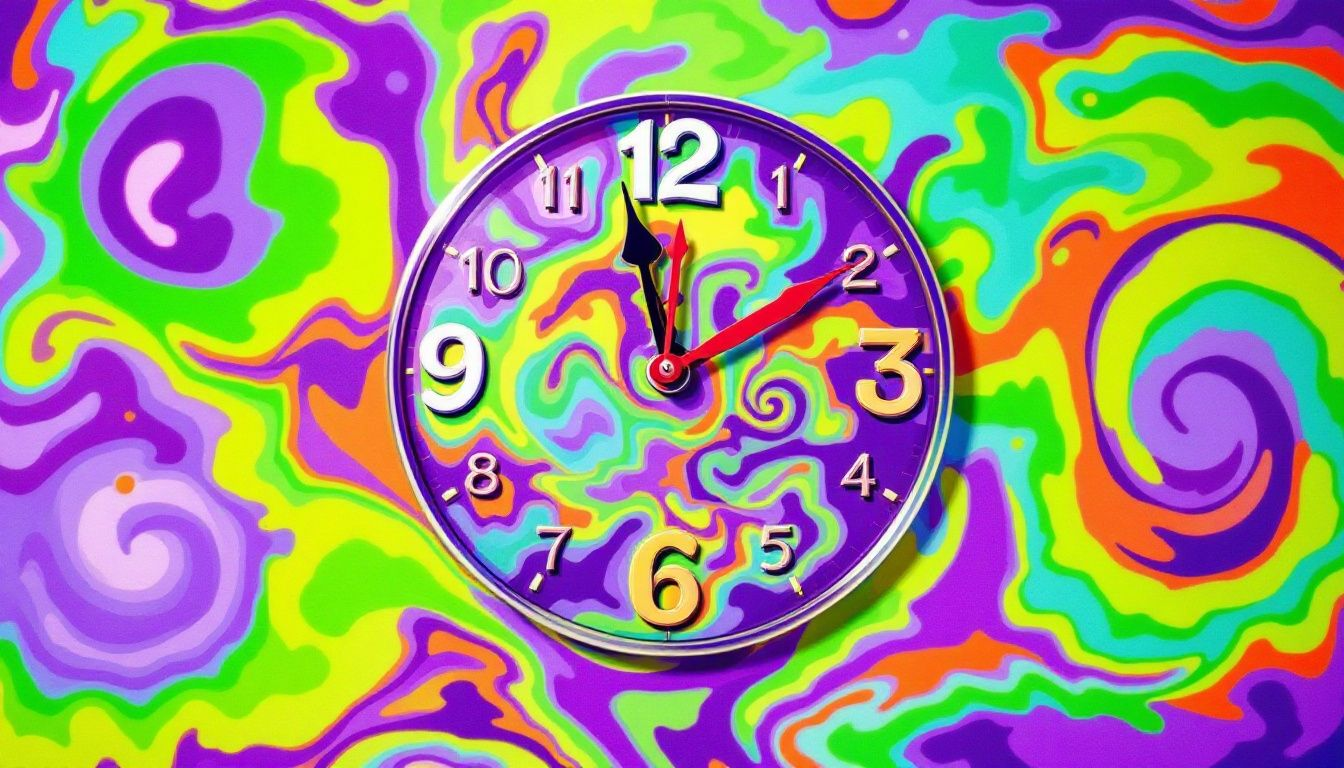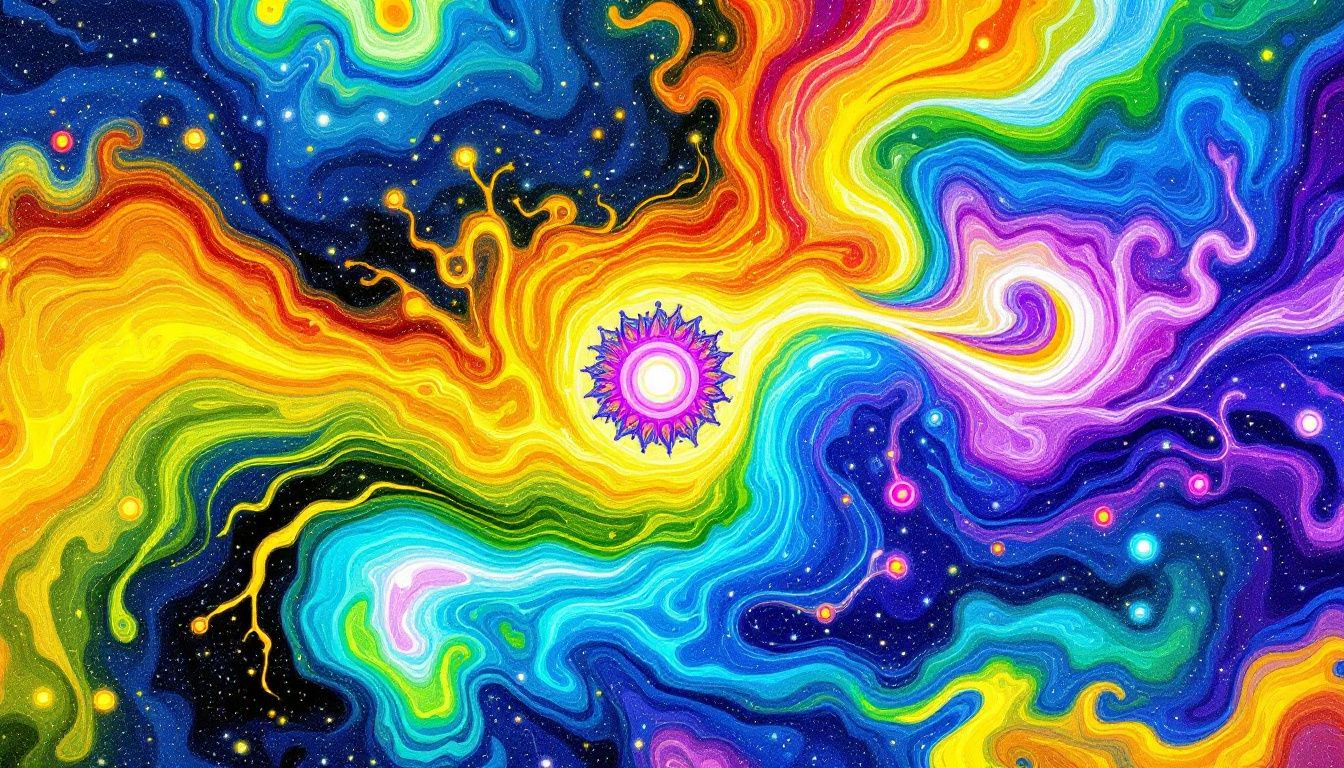How Long Does Acid Last? Duration, Effects, and Safety Tips
Wondering how long does acid last? An LSD trip usually starts within 20-60 minutes and can last up to 12 hours. Aftereffects may linger longer. Factors like dosage, metabolism, and environment affect this duration. In this article, we’ll explore these aspects in detail.
Key Takeaways
LSD, a potent psychedelic, alters perception and mood by interacting with serotonin receptors, with effects varying based on dosage and individual mental state.
An acid trip typically lasts up to 12 hours, with onset occurring within 20 to 60 minutes, peak effects at 2 to 4 hours, and a gradual comedown that can last up to 24 hours.
Long-term use of LSD can lead to significant psychological risks, including Hallucinogen Persisting Perception Disorder (HPPD) and psychological dependence, highlighting the importance of informed and cautious usage.
Understanding LSD (Lysergic Acid Diethylamide)

LSD, short for lysergic acid diethylamide, is a potent psychedelic substance known for its ability to dramatically alter perception, cognition, and mood. This hallucinogenic drug primarily interacts with the serotonin receptor in the brain, especially the 5-HT2A receptor, which plays a crucial role in regulating mood, behavior, and sensory perception. Liquid lsd induces a wide range of experiences by interacting with these receptors, producing effects from profound euphoria to deep fear, making each acid trip unique and unpredictable. The interaction of these lsd molecules with serotonin receptors is key to understanding the drug’s effects.
The effects of LSD are not just limited to the mind; they also encompass various physical symptoms. Users may experience an increased heart rate, elevated blood pressure, and a rise in body temperature. These physiological changes, combined with the intense psychological effects, contribute to the overall impact of the LSD experience.
The variability in LSD’s effects can be attributed to several factors, including the dosage consumed and the individual’s mental state at the time of use. This unpredictability underscores the importance of understanding both the potential benefits and risks associated with taking LSD. Whether you’re seeking a spiritual journey or just curious about the psychedelic effects, being well-informed is the first step towards a safer and more insightful experience.
Duration of an Acid Trip

An acid trip can be an extended journey, often lasting up to a full day, although most trips are under 12 hours. The duration of an LSD trip is influenced by several factors, including the dose and the individual’s metabolism. Typically, the effects of LSD begin within 20 to 60 minutes after ingestion, marking the start of a profound and often unpredictable experience.
The peak effects of LSD usually occur 2 to 4 hours after ingestion, characterized by intense visual and auditory hallucinations. As the trip progresses, the comedown phase sets in, where the effects gradually diminish but can still linger for hours.
During this time, individuals may feel physically exhausted and dehydrated, highlighting the importance of self-care during and after the trip. Knowing how long an acid trip can last and what to expect at each stage can help you prepare for the journey and manage your experience more effectively.
Onset of Effects
The onset of an acid trip generally begins between 20 to 90 minutes after ingestion, with oral consumption typically manifesting effects within 20 to 30 minutes. If LSD is administered intravenously, the effects can start as quickly as 10 minutes. As the initial effects begin to take hold, users might feel a sense of anticipation or excitement, signaling the start of their psychedelic journey.
During this early phase, some common signs of LSD’s effects include brighter colors, sharper sounds, and noticeable mood changes. These initial sensory enhancements set the stage for the more profound and immersive experiences that define the peak of an LSD trip.
Understanding the onset of effects can help users recognize when the drug is taking hold and prepare for the ensuing adventure.
Peak Experience
The peak of an acid trip, commonly referred to as the most intense part, typically occurs between 2 and 4 hours after consumption. During this period, users may experience significant alterations in perception, including the blending of senses, known as synesthesia. Visual hallucinations become particularly vivid, often featuring intricate patterns and vibrant colors during acid trips.
This peak experience can also evoke strong emotional responses, ranging from profound euphoria to deep distress. Users often report feeling a heightened connection to their surroundings, which can amplify both positive and negative experiences.
The type of LSD and the environment in which it is consumed can significantly impact the intensity and nature of the peak experience. Being aware of these potential highs and lows can help users navigate their trip more effectively and prepare for any emotional extremes they might encounter.
Comedown and Aftereffects

The comedown phase of an acid trip involves a gradual reduction of the effects, with the body and mind returning to normal within up to 24 hours. During this time, individuals may experience changes in mood, physical fatigue, and altered thought patterns as their body adjusts. Many users report an ‘afterglow’ effect that may last up to 6 hours after the trip, characterized by feelings of positivity and well-being.
Minimizing fatigue and discomfort during the comedown involves staying nourished and hydrated. Awareness of the comedown and aftereffects can help users prepare for the end of their trip and ensure a smoother transition back to their everyday state of mind.
Factors Influencing Trip Duration
The duration and intensity of an acid trip can be influenced by several factors, including how acid affects the dosage and potency of the LSD consumed. Individual metabolism plays a significant role, as variations in metabolic rates can cause differences in how long LSD effects last.
Additionally, the concurrent use of other substances, such as stimulants or depressants, can significantly alter the effects and duration of an LSD trip. Being aware of these factors can help users better predict and manage their experiences.
How Long Does LSD Stay in Your System?

LSD can be detected in different drug tests for varying lengths of time, depending on the method used. Typically, LSD is detectable in urine for 1 to 4 days, influenced by factors such as dosage and individual metabolism. In hair tests, LSD can be detected for up to 90 days, although such testing is rare.
These detection windows highlight the importance of understanding how long LSD remains in your system and the potential implications for drug test.
Urine Tests
Urine tests are a common method for detecting LSD, primarily identifying metabolites like 2-oxo-LSD, which remain in the system longer than the drug itself. LSD can typically be detected in urine for up to four days after consumption, depending on various factors such as dosage and metabolism.
The sensitivity of urine tests to LSD metabolites makes them an effective tool to detect LSD use.
Blood Tests
Blood tests for LSD detection are less common due to the short detection window. LSD can be detected in blood for up to 12 hours following ingestion. While blood tests are a method used in drug testing, their limited timeframe makes them less practical for identifying LSD use compared to other drug testing methods.
Hair Tests
Hair tests offer a longer detection window, potentially identifying LSD use for up to 90 days. Despite this extended timeframe, hair tests for LSD are infrequently utilized. The longer detection period provides a broader view of drug use history, although it’s less commonly employed compared to urine or blood tests.
Long-Term Effects and Risks
While the immediate effects of LSD can be profound, the long-term risks are also significant. LSD has the potential to trigger mental health issues. It can also worsen conditions like anxiety and psychosis. Long-term use may lead to severe psychological issues, including persistent depressive episodes or acute psychosis in some individuals. Those with preexisting mental health concerns or on certain medications should exercise caution or avoid LSD altogether.
The dramatic changes in brain chemistry caused by LSD can lead to long-term effects, even if the initial experience seems positive. For instance, some users might experience prolonged visual distortions or other sensory disturbances, a condition known as hallucinogen persisting perception disorder (HPPD). The potential for negative reactions underscores the importance of understanding the risks before taking LSD.
Even small amounts of LSD can induce hallucinations, making it one of the most potent hallucinogens available. Negative effects may decrease over time, but some individuals might experience prolonged issues that require medical or psychological intervention, including drug induced psychosis. Being aware of these risks can help users make more informed decisions about LSD use.
Hallucinogen Persisting Perception Disorder (HPPD)
Hallucinogen Persisting Perception Disorder (HPPD) is a condition characterized by persistent sensory disturbances long after the drug’s effects have worn off. These disturbances can include visual hallucinations, altered motion perception, and intensified colors. HPPD can last from months to years, with some cases persisting for up to 5 years.
There are two types of HPPD: type 1, which involves brief, random flashbacks, and type 2, which is more chronic and severe with longer episodes. Flashbacks can occur unexpectedly, causing unease and distress for the individual. HPPD is a rare condition, affecting only about 4% to 4.5% of individuals who have used hallucinogens.
Repeated LSD use may increase the risk of experiencing flashbacks and developing HPPD. Awareness of this condition and its implications can help users prepare for the potential long-term effects of LSD and seek appropriate medical advice if needed.
Psychological Dependence and Tolerance
LSD can lead to psychological dependence, where users develop a strong attachment to the psychedelic experience. This dependence is largely psychological rather than physical, as LSD does not cause withdrawal symptoms. However, tolerance to LSD can develop rapidly, requiring larger doses to achieve similar effects.
Tolerance to LSD typically dissipates after a period of abstinence, suggesting that any dependence is primarily mental. Underlying mental health issues can exacerbate the risk of lasting effects such as anxiety and depression after using LSD.
The unpredictability of LSD’s effects can also lead to varying experiences, ranging from euphoric sensations to distressing episodes. Understanding these risks can help users manage their LSD use more responsibly and seek help if they develop psychological dependence.
Safety Tips for Using LSD
When taking LSD, preparation and safety are paramount. Knowing the substance you are using and mentally preparing for the experience can significantly reduce the risk of a bad acid trip. Staying hydrated throughout the experience helps mitigate physical side effects. Having a sober trip sitter present can provide support and assistance, enhancing the overall safety of the trip.
Choosing a comfortable and secure environment can also reduce the risk of a bad trip. Starting with a low dose allows users to gauge their reaction before potentially increasing the amount. Avoiding the mix of LSD with other substances, especially alcohol, can prevent complications and reduce the likelihood of experiencing adverse effects.
Following these safety tips can help users have a more positive and controlled LSD experience.
Legal Status of LSD
LSD is classified as a Schedule I controlled substance, making it illegal to possess, sell, or manufacture. This classification was enacted in the 1960s, reflecting the government’s stance on the dangers associated with LSD use. Being caught with LSD can lead to serious consequences. These may include criminal charges, fines, probation, or imprisonment.
Penalties for selling LSD can be severe, with sentences ranging from five to 40 years, depending on the quantity involved. Fines for serious offenses can reach up to $2 million.
Awareness of the legal ramifications is crucial for anyone considering experimenting with this powerful hallucinogenic drug.
Treatment for LSD Use
Those struggling with LSD use have various treatment options available. Therapy, particularly Cognitive Behavioral Therapy (CBT), is often used to help individuals understand and change their behavior patterns related to drug use. Treatment can be conducted at inpatient or outpatient centers, depending on the severity of the addiction. Additionally, Dialectical Behavioral Therapy and lifestyle skills therapy can provide support in managing the psychological aspects of LSD dependence.
Doctors may prescribe medications to address anxiety. They may also be used to help manage depression or other drugs related to LSD use. Medication-Assisted Treatment (MAT) can help alleviate withdrawal symptoms and manage co-occurring mental health disorders. Dual diagnosis treatment addresses both substance use and any underlying mental health concerns, ensuring a comprehensive approach to recovery.
The Substance Abuse and Mental Health Services Administration (SAMHSA) offers a National Helpline, providing confidential information and referrals for treatment and support available 24/7. Insurance often covers addiction treatment, helping to alleviate the financial burden for those seeking help. Being aware of the available treatment options and resources can be a critical first step towards recovery.
Summary
LSD, or lysergic acid diethylamide, is a powerful hallucinogenic drug with profound effects on perception, mood, and cognition. An acid trip can last up to 12 hours, with a peak experience occurring 2 to 4 hours after ingestion. The onset of effects can be felt within 20 to 60 minutes, and the comedown phase can last up to 24 hours. Factors such as dosage, individual metabolism, and concurrent substance use can influence the duration and intensity of an LSD trip.
While LSD can offer unique and profound experiences, it also carries significant risks, including long-term mental health issues, hallucinogen persisting perception disorder (HPPD), and psychological dependence. Safety tips such as preparing mentally, staying hydrated, and having a sober trip sitter can help mitigate these risks. Understanding the legal status of LSD and the available treatment options is crucial for anyone considering or struggling with LSD use. Being well-informed and cautious can help ensure a safer and more insightful psychedelic journey.










